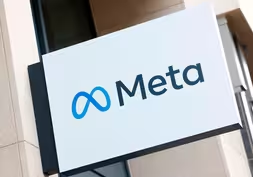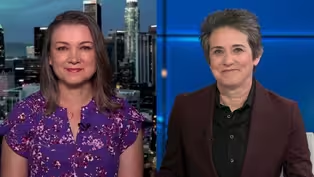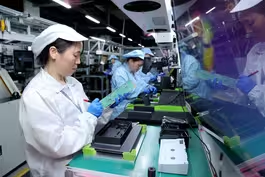
Farmers turn to seaweed to reduce methane emissions
Clip: 4/14/2025 | 7m 45sVideo has Closed Captions
Farmers turn to seaweed in attempt to reduce methane emissions from livestock
As the world races to curb climate change, scientists are taking aim at cows, a surprisingly potent source of greenhouse gases. Science correspondent Miles O’Brien traveled from California to Mexico and Australia to explore a bold idea that could make a big impact. It's part of our series, Tipping Point.
Problems playing video? | Closed Captioning Feedback
Problems playing video? | Closed Captioning Feedback
Major corporate funding for the PBS News Hour is provided by BDO, BNSF, Consumer Cellular, American Cruise Lines, and Raymond James. Funding for the PBS NewsHour Weekend is provided by...

Farmers turn to seaweed to reduce methane emissions
Clip: 4/14/2025 | 7m 45sVideo has Closed Captions
As the world races to curb climate change, scientists are taking aim at cows, a surprisingly potent source of greenhouse gases. Science correspondent Miles O’Brien traveled from California to Mexico and Australia to explore a bold idea that could make a big impact. It's part of our series, Tipping Point.
Problems playing video? | Closed Captioning Feedback
How to Watch PBS News Hour
PBS News Hour is available to stream on pbs.org and the free PBS App, available on iPhone, Apple TV, Android TV, Android smartphones, Amazon Fire TV, Amazon Fire Tablet, Roku, Samsung Smart TV, and Vizio.
Providing Support for PBS.org
Learn Moreabout PBS online sponsorshipWILLIAM BRANGHAM: In the ongoing effort to curb# climate change, scientists are taking aim at a## surprisingly potent source of the greenhouse# gases that are warming our planet, cows.
As part of our Tipping Point series, science# correspondent Miles O'Brien traveled from## California to Mexico and even to Australia to# explore a bold idea that could make a big impact.
MILES O'BRIEN: It's 0 dark 30 at the Straus# Dairy Farm in Marin County, California.
The## cows stand patiently in line, ready for the# morning milking.
At the helm is Albert Straus.
ALBERT STRAUS, Straus Family Creamery:# I want to make a farming system that's a## positive impact on the environment, at the# same time produce high-quality organic food.
MILES O'BRIEN: So methane is never far from# his mind.
It's an especially potent greenhouse## gas.
Over 20 years, it traps about 80 times# more heat than carbon dioxide.
Dairy cows and## beef cattle emit a significant amount of it.
It# mostly comes from their burps, not flatulence.
In fact, methane emissions from livestock exceed# the oil and gas industry.
It's a stubborn problem.## And, for Albert, it threatens to derail his# goal of achieving carbon neutrality by 2030.
ALBERT STRAUS: Cows have an essential# role in reversing climate change.
MILES O'BRIEN: That's why, in 2021, he# jumped at the chance to become the first## commercial dairy in the U.S. to test# a novel methane mitigation solution,## seaweed in the feed.
He enrolled# two dozen cows in a two-month trial.
ALBERT STRAUS: The things that we were testing for# didn't have any effects on animal health or human## health.
There was no off-flavors or effects on the# quality of the milk or the quantity of the milk.
MILES O'BRIEN: The additive comes from a# red seaweed called asparagopsis taxiformis.## It was less than a half-a-percent of the# cows' diet, but the results were dramatic.
ALBERT STRAUS: An average of 52 percent reduction,## with some cows over 80 percent,# and then one cow over 90 percent.
MILES O'BRIEN: University of California# Davis animal University of California## Davis animal scientist Ermias# Kebreab consulted on the study.## He is a world leader in the quest to# cut methane emissions from livestock.
ERMIAS KEBREAB, University of California, Davis:# I think we can produce high-quality protein,## high-quality milk, at the# same time help the planet.
MILES O'BRIEN: To gather data on how# much methane a cow might be exhaling,## they use a device called GreenFeed.
As# the cows lick, chew, breathe, and belch,## the gases they exhale are sucked# into a tube for real-time analysis.
ERMIAS KEBREAB: So it will# analyze the contents of the## breath in different concentrations of the gases.
MILES O'BRIEN: Hello.
How are you.
How are you?
They are recording impressive results.# Cows that consume just a quarter of 1## percent seaweed in their diet# emit 30 percent less methane.
ERMIAS KEBREAB: We are kind of slowly# introducing the higher dose now.
MILES O'BRIEN: What do you# think the upward limit is?
ERMIAS KEBREAB: In the literature, there# is a report that 98 percent reduction.
MILES O'BRIEN: Ninety-eight?
ERMIAS KEBREAB: Ninety-eight percent re..
MILES O'BRIEN: And that's with only# one-half of 1 percent seaweed additive.
So,## why do cows produce so much# methane?
To understand that,## we need to ruminate literally on the# rumen, the first of four compartments## in a cows stomach.
Here, microbes start the# whole process of turning grass into energy.
But this fermentation also releases# carbon dioxide, CO2, and hydrogen,## H2.
With the help of a special enzyme, those# molecules are converted to methane, CH4,## and exhaled.
But this process can be disrupted# by an ingredient in seaweed called bromoform.## It disables that enzyme, preventing# the CO2 and H2 from forming methane.
And the hydrogen is now for the cow.
Effective as# it appears to be, a lot of it needs to be grown## to make a dent in livestock methane production.# That's what they are working on here in Mexico,## 140 miles south of San Diego in the tiny# community of Ejido Erendira.
The U.S. start-up## that performed the study at the Straus Dairy# Farm is shifting into large-scale production.
This is the Blue Ocean Barns seaweed farm.
HANNAH RESETARITS, Blue Ocean Barns:# So this is called the sun tube.
MILES O'BRIEN: The senior manager of operations# expansion, Hannah Resetarits, gave me a .. HANNAH RESETARITS: All of our# cultures start in this room and## then scale outside all the way up# through our different vessel sizes.
MILES O'BRIEN: Outdoors, they scale# up in 17,000-gallon shallow vessels.## Scientists are still learning what# the seaweed likes and what it doesn't.
You're trying to scale up and still understand## some basic science at the same# time, which is a challenge, right?
HANNAH RESETARITS: Oh, 100 percent, yes.
It is# something that makes this job very exciting.
It## also means that, as we go, we are also going# back and improving our systems every day.
MILES O'BRIEN: Joan Salwen is the# co-founder and CEO of Blue Ocean Barns.
JOAN SALWEN, Co-Founder and CEO, Blue Ocean# Barns: It became clear that this kind of## finicky seaweed was not just going to become# domesticated without a little bit of a fight.
MILES O'BRIEN: The company has raised# $35 million.
It is in talks with some## major food producers, scrambling for# ways to meet carbon neutrality targets.
JOAN SALWEN: Not one of them will get to# carbon neutral without our product.
And if## they continue to feel pressure to make good# on their promise, I feel very, very bullish.
MILES O'BRIEN: Nice one.
But she does face a serious roadblock.
In the# U.S., the Food and Drug.. category for products aimed at reducing# greenhouse gases.
If bromoform from## seaweed is considered a veterinary drug, the# approval process might take five to 10 years,## far too long, given the# urgency of the climate crisis.
JOAN SALWEN: We're a little# stuck in the United States.
MILES O'BRIEN: Studies show no toxicity and no## adverse effects.
Australia has already# approved seaweed feed for livestock.
I'm going to have a simply# grilled with cheese, please.
SAM ELSOM, Co-Founder and CEO, Sea# Forest: Yes, two of those, thank you.
MILES O'BRIEN: In fact, low-methane burgers have# been on the market down under for two year..
I tried one in Sydney with Sam Elsom, co-founder# and CEO of the Tasmania-based seaweed producer Sea## Forest.
Australia didn't classify the additive# as a drug, which made approval much faster.
SAM ELSOM: I'm grateful that we live in# Australia.
It should happen in the U.S.,## for sure.
It should happen all around the world.
MILES O'BRIEN: It's a solution# without a negative that I could taste.
(LAUGHTER) SAM ELSOM: That's true.
MILES O'BRIEN: Scientists say we must cut# global greenhouse .. 2030 in order to limit global warming to 2.7# degrees Fahrenheit.
But we are headed in the## opposite direction.
Emissions are still rising.
As# it turns out, a big solution might be bite-sized.
For the "PBS News Hour," I'm Miles# O'Brien in Sydney, Australia.
Blues musician Nat Myers faces battle with a rare cancer
Video has Closed Captions
Clip: 4/14/2025 | 5m 22s | Acclaimed blues musician Nat Myers faces battle with a rare cancer (5m 22s)
How Meta's antitrust trial could have major implications
Video has Closed Captions
Clip: 4/14/2025 | 6m 2s | How Meta's blockbuster antitrust trial could have major implications for big tech (6m 2s)
News Wrap: Penn. arson suspect charged with terrorism
Video has Closed Captions
Clip: 4/14/2025 | 5m 42s | News Wrap: Man accused of targeting Shapiro charged with attempted homicide and terrorism (5m 42s)
Russian cluster bomb attack on Ukraine kills dozens
Video has Closed Captions
Clip: 4/14/2025 | 3m 57s | Russian cluster bomb attack on Ukraine kills dozens, including children (3m 57s)
Tamara Keith and Amy Walter on voters and Trump's policies
Video has Closed Captions
Clip: 4/14/2025 | 7m 47s | Tamara Keith and Amy Walter on what voters think about Trump's economic policies (7m 47s)
Tariff confusion injects more uncertainty into economy
Video has Closed Captions
Clip: 4/14/2025 | 8m 2s | Confusion over electronics tariffs injects more uncertainty into economy (8m 2s)
Trump, El Salvador reject responsibility for deported man
Video has Closed Captions
Clip: 4/14/2025 | 6m 51s | Trump, El Salvador's president indicate no intention of returning mistakenly deported man (6m 51s)
Providing Support for PBS.org
Learn Moreabout PBS online sponsorship
- News and Public Affairs

FRONTLINE is investigative journalism that questions, explains and changes our world.

- News and Public Affairs

Amanpour and Company features conversations with leaders and decision makers.












Support for PBS provided by:
Major corporate funding for the PBS News Hour is provided by BDO, BNSF, Consumer Cellular, American Cruise Lines, and Raymond James. Funding for the PBS NewsHour Weekend is provided by...






